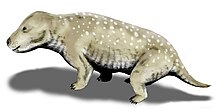Exaeretodon
| Exaeretodon | |
|---|---|

| |
| Exhibit at Mori Tower | |
| Scientific classification | |
| Domain: | Eukaryota |
| Kingdom: | Animalia |
| Phylum: | Chordata |
| Clade: | Synapsida |
| Clade: | Therapsida |
| Clade: | Cynodontia |
| Family: | †Traversodontidae |
| Subfamily: | †Gomphodontosuchinae |
| Genus: | †Exaeretodon Cabrera 1943 |
| Species | |
| |
| Synonyms | |
| |
Exaeretodon is an extinct genus of traversodontid cynodonts; four species are known, from various formations. E. argentinus is from the Carnian-age (Upper Triassic) Ischigualasto Formation of Argentina. E. major and E. riograndensis are from the Ladinian-age (Middle Triassic) portion of the Santa Maria Formation of Brazil. E. statisticae is from the Carnian-age Lower Maleri Formation of India.
Description


This genus was an herbivore up to 1.8 meters (5.9 feet) long, with a specialized grinding action when feeding.
An analysis of the size of the bones of calves collected in Paleorrota concluded that the mother Exaeretodon had one or two calves, for one pregnancy.[citation needed]
Taxonomy
When he first named the species, Argentine paleontologist José Bonaparte mentioned several features that distinguish it from all other traversodontids. The tooth rows of the upper jaw are more parallel to each other in I. sudamericanus than they are in Exaeretodon, and they are also inset closer to the inside of the mouth. There are also more postcanine teeth oriented toward middle of the subtemporal fenestrae (two holes in the bottom of the skull) and ascending rama of the dentary (projections of the lower jaw that extend up to the skull). The ascending rama are also wider and taller in the I. sudamericanus specimen. The orbit or eye socket is longer than that of Exaeretodon, as are the palatine bones.[1]
Despite the differences, a 2007 study concluded that the I. sudamericanus skull represents the same species as E. argentinus. Using allometry, paleontologist Jun Liu found I. sudamericanus to be the largest known example of a growth series in E. argentinus. Thus, Ischignathus is now regarded as a junior synonym of Exaeretodon. As the animal grew, the proportions of bones changed. These differing proportions were initially seen as species-distinguishing characters, but are now regarded as natural ontogenic variation.[1]
See also
 Media related to Exaeretodon at Wikimedia Commons
Media related to Exaeretodon at Wikimedia Commons- Ischigualasto Formation
References
- ^ a b Liu, J. (2007). "The taxonomy of the traversodontid cynodonts Exaeretodon and Ischignathus" (PDF). Revista Brasileira de Paleontologia. 10 (2): 133–136. doi:10.4072/rbp.2007.2.07.
- Cynognathian genera
- Ladinian first appearances
- Carnian extinctions
- Middle Triassic synapsids of South America
- Late Triassic synapsids of South America
- Triassic Argentina
- Fossils of Argentina
- Triassic Brazil
- Fossils of Brazil
- Triassic synapsids of Asia
- Fossils of India
- Fossil taxa described in 1943
- Taxa named by Ángel Cabrera






